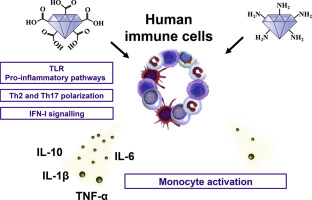Our official English website, www.x-mol.net, welcomes your feedback! (Note: you will need to create a separate account there.)
Impact of the surface functionalization for nanodiamonds biocompatibility: A comprehensive view on ex vivo human blood immune cell types
Carbon ( IF 10.9 ) Pub Date : 2020-04-01 , DOI: 10.1016/j.carbon.2020.01.003 Laura Fusco , Elisabetta Avitabile , Valentina Armuzza , Marco Orecchioni , Akcan Istif , Davide Bedognetti , Tatiana Da Ros , Lucia Gemma Delogu
Carbon ( IF 10.9 ) Pub Date : 2020-04-01 , DOI: 10.1016/j.carbon.2020.01.003 Laura Fusco , Elisabetta Avitabile , Valentina Armuzza , Marco Orecchioni , Akcan Istif , Davide Bedognetti , Tatiana Da Ros , Lucia Gemma Delogu

|
Abstract Nanodiamonds (NDs) represent a class of carbon nanostructures widely investigated as promising biomedical nanotools. The possible immune system reactions indicate success or failure for any nanosystem bioapplication. Moreover the assessment of the role of nanomaterial functionalization on the immune system response needs to be fully elucidated. We aimed to dissect the immunologic impact of two NDs differing for their functionalization, carboxylic acid modified NDs (NDs-COOH) and amino-functionalized NDs (NDs-NH2), presenting a glycolic chain as spacer. We used human peripheral blood mononuclear cells (PBMCs) as model for potential biomedical scenario of NDs interaction with the human body. The ND immunologic effects were depicted toward the complex mix of PBMCs. The results showed that both functionalizations possess high hemocompatibility but NDs-COOH induced a cell viability reduction, affecting monocytes. The ND impact was depicted through immune activation markers, immune-response gene expression and cytokine secretion analysis. Immune markers confirmed the impact on monocytes, more evident for NDs-COOH. Both NDs affected the immune response, however NDs-COOH showed more prominent responses, evoking pronounced regulation of immune-modulatory transcripts. The cytokine analysis confirmed gene expression data for proinflammatory cytokines related to the innate response. Our findings reveal that NDs decoration with an amino-terminating chain enhances their immunologic compatibility.
中文翻译:

表面功能化对纳米金刚石生物相容性的影响:对离体人类血液免疫细胞类型的综合看法
摘要 纳米金刚石 (NDs) 代表一类碳纳米结构,作为有前途的生物医学纳米工具被广泛研究。可能的免疫系统反应表明任何纳米系统生物应用的成功或失败。此外,需要充分阐明纳米材料功能化对免疫系统反应作用的评估。我们的目的是剖析两种功能化不同的 NDs,羧酸修饰的 NDs (NDs-COOH) 和氨基功能化的 NDs (NDs-NH2) 的免疫影响,将乙醇链作为间隔物。我们使用人类外周血单核细胞 (PBMC) 作为 NDs 与人体相互作用的潜在生物医学场景的模型。ND 免疫效应被描述为 PBMC 的复杂混合物。结果表明,两种功能化都具有高血液相容性,但 NDs-COOH 诱导细胞活力降低,影响单核细胞。ND 影响是通过免疫激活标记、免疫反应基因表达和细胞因子分泌分析来描述的。免疫标记证实了对单核细胞的影响,对 NDs-COOH 的影响更为明显。两种 NDs 都会影响免疫反应,但 NDs-COOH 表现出更突出的反应,引起免疫调节转录物的显着调节。细胞因子分析证实了与先天反应相关的促炎细胞因子的基因表达数据。我们的研究结果表明,带有氨基终止链的 NDs 装饰增强了它们的免疫相容性。ND 影响是通过免疫激活标记、免疫反应基因表达和细胞因子分泌分析来描述的。免疫标记证实了对单核细胞的影响,对 NDs-COOH 的影响更为明显。两种 NDs 都会影响免疫反应,但 NDs-COOH 表现出更突出的反应,引起免疫调节转录物的显着调节。细胞因子分析证实了与先天反应相关的促炎细胞因子的基因表达数据。我们的研究结果表明,带有氨基终止链的 NDs 装饰增强了它们的免疫相容性。ND 影响是通过免疫激活标记、免疫反应基因表达和细胞因子分泌分析来描述的。免疫标记证实了对单核细胞的影响,对 NDs-COOH 的影响更为明显。两种 NDs 都会影响免疫反应,但 NDs-COOH 表现出更突出的反应,引起免疫调节转录物的显着调节。细胞因子分析证实了与先天反应相关的促炎细胞因子的基因表达数据。我们的研究结果表明,带有氨基终止链的 NDs 装饰增强了它们的免疫相容性。引起对免疫调节转录物的显着调节。细胞因子分析证实了与先天反应相关的促炎细胞因子的基因表达数据。我们的研究结果表明,带有氨基终止链的 NDs 装饰增强了它们的免疫相容性。引起对免疫调节转录物的显着调节。细胞因子分析证实了与先天反应相关的促炎细胞因子的基因表达数据。我们的研究结果表明,带有氨基终止链的 NDs 修饰增强了它们的免疫相容性。
更新日期:2020-04-01
中文翻译:

表面功能化对纳米金刚石生物相容性的影响:对离体人类血液免疫细胞类型的综合看法
摘要 纳米金刚石 (NDs) 代表一类碳纳米结构,作为有前途的生物医学纳米工具被广泛研究。可能的免疫系统反应表明任何纳米系统生物应用的成功或失败。此外,需要充分阐明纳米材料功能化对免疫系统反应作用的评估。我们的目的是剖析两种功能化不同的 NDs,羧酸修饰的 NDs (NDs-COOH) 和氨基功能化的 NDs (NDs-NH2) 的免疫影响,将乙醇链作为间隔物。我们使用人类外周血单核细胞 (PBMC) 作为 NDs 与人体相互作用的潜在生物医学场景的模型。ND 免疫效应被描述为 PBMC 的复杂混合物。结果表明,两种功能化都具有高血液相容性,但 NDs-COOH 诱导细胞活力降低,影响单核细胞。ND 影响是通过免疫激活标记、免疫反应基因表达和细胞因子分泌分析来描述的。免疫标记证实了对单核细胞的影响,对 NDs-COOH 的影响更为明显。两种 NDs 都会影响免疫反应,但 NDs-COOH 表现出更突出的反应,引起免疫调节转录物的显着调节。细胞因子分析证实了与先天反应相关的促炎细胞因子的基因表达数据。我们的研究结果表明,带有氨基终止链的 NDs 装饰增强了它们的免疫相容性。ND 影响是通过免疫激活标记、免疫反应基因表达和细胞因子分泌分析来描述的。免疫标记证实了对单核细胞的影响,对 NDs-COOH 的影响更为明显。两种 NDs 都会影响免疫反应,但 NDs-COOH 表现出更突出的反应,引起免疫调节转录物的显着调节。细胞因子分析证实了与先天反应相关的促炎细胞因子的基因表达数据。我们的研究结果表明,带有氨基终止链的 NDs 装饰增强了它们的免疫相容性。ND 影响是通过免疫激活标记、免疫反应基因表达和细胞因子分泌分析来描述的。免疫标记证实了对单核细胞的影响,对 NDs-COOH 的影响更为明显。两种 NDs 都会影响免疫反应,但 NDs-COOH 表现出更突出的反应,引起免疫调节转录物的显着调节。细胞因子分析证实了与先天反应相关的促炎细胞因子的基因表达数据。我们的研究结果表明,带有氨基终止链的 NDs 装饰增强了它们的免疫相容性。引起对免疫调节转录物的显着调节。细胞因子分析证实了与先天反应相关的促炎细胞因子的基因表达数据。我们的研究结果表明,带有氨基终止链的 NDs 装饰增强了它们的免疫相容性。引起对免疫调节转录物的显着调节。细胞因子分析证实了与先天反应相关的促炎细胞因子的基因表达数据。我们的研究结果表明,带有氨基终止链的 NDs 修饰增强了它们的免疫相容性。


























 京公网安备 11010802027423号
京公网安备 11010802027423号